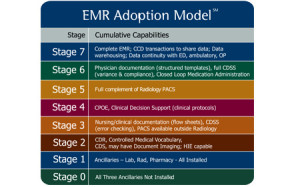I recently participated as the CIO reviewer on a HIMSS Analytics Stage 7 validation. The long travel to the West Coast aside, I was happy to contribute my time and expertise to be exposed to an advanced
organization and to meet a wonderful group of leaders. The review team also included a Chief Medical Information Officer and the HIMSS Analytics Regional Director for North America.
As of the 3rd quarter this year, only 4.6% of hospitals have achieved Stage 7 while 30.5% have achieved Stage 6. Just over a third of hospitals are currently at Stage 5.
All three hospitals I’ve served as CIO have achieved Stage 6. Getting from Stage 6 to 7 is a significant leap. There is a greater focus on analytics and using the data from the electronic health record to improve patient outcomes.
From the HIMSS Analytics website, here is how Stage 7 is described:
The hospital no longer uses paper charts to deliver and manage patient care and has a mixture of discrete data, document images, and medical images within its EMR environment. Data warehousing is being used to analyze patterns of clinical data to improve quality of care, patient safety, and care delivery efficiency. Clinical information can be readily shared via standardized electronic transactions (i.e., CCD) with all entities that are authorized to treat the patient, or a health information exchange (i.e., other non-associated hospitals, ambulatory clinics, sub-acute environments, employers, payers and patients in a data sharing environment). The hospital demonstrates summary data continuity for all hospital services (e.g., inpatient, outpatient, ED, and with any owned or managed ambulatory clinics). Blood products and human milk are included in the closed-loop medication administration process.
The orientation session on validation day was attended by a broad range of IT, operational and clinical leadership. That alone demonstrates the importance of achieving Stage 7 – it is not about IT. It is about the entire organization and how they deliver care.
This first session includes an overview of the organization, systems, governance, interoperability, disaster recovery, and analytics. Several case studies are presented. The review team gets a good sense of the organization – what they’ve accomplished with their electronic health record and how they’ve done it.
The overview session is followed by tours and interviews of key areas: several nursing units, emergency department, NICU, pharmacy, radiology, blood bank, and health information management. There are key indicators of system use and being paperless that we look for in all areas. In the NICU, we look at how breast milk is being managed using bar codes. In the blood bank, we look at how blood products are managed and tracked using bar codes. These latter two are key components of Stage 7 that many Stage 6 organizations still need to implement.
As we tour, we are able to get a sense of the organization overall. On our visit, it was obvious that collaboration and transparency were a strong part of this organization’s culture. Many health care best practices were evident aside from the technology. My “aha moment” was realizing the strong correlation between an organization’s focus on operational excellence with their advanced use of technology. Clearly, you can’t have one without the other.
When HIMSS Analytics first rolled out the EMR Adoption Model (EMRAM) concept and framework, I was the CIO at Brigham and Women’s Hospital in Boston. We thought we were pretty advanced. We had implemented computerized physician order entry (CPOE as it was called then) in the early 1990’s and the electronic medication administration record (EMAR) in 2005. Yet the EMRAM framework ordered key systems and applications into stages in such a way that Brigham was not as high on the model as we expected. It seemed somewhat arbitrary at the time and I remember debating with them using Brigham as the example.
Since that time, HIMSS Analytics has evolved the acute care EMRAM model and has developed a parallel model for ambulatory. Over time I have come to respect HIMSS Analytics for pursuing the EMRAM framework and setting the bar high for our industry. Health care provider organizations aspire to reach Stage 6 and 7 and learn from one another on their journeys. And our patients benefit – with advanced use of technology, organizations all over the country are demonstrating improved patient outcomes, patient safety and operational efficiencies.
And that’s a win for all of us.
Related link:

